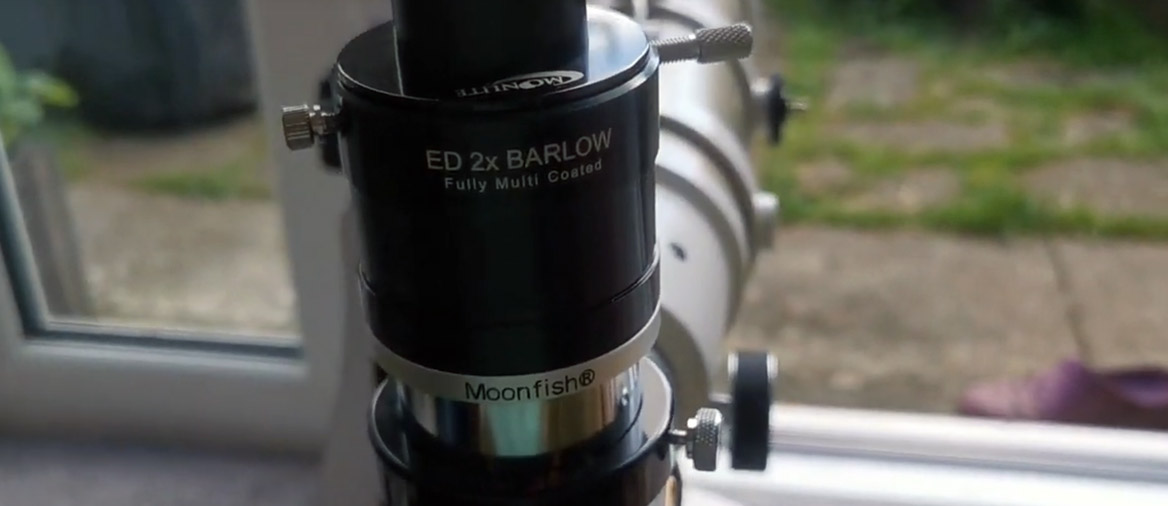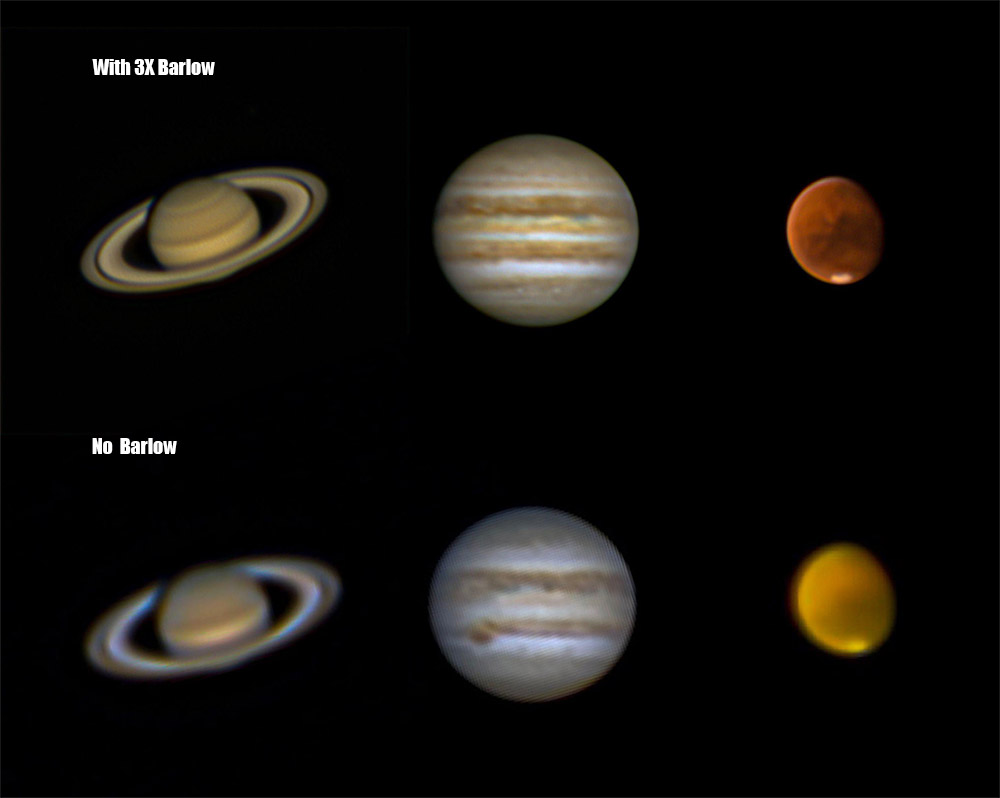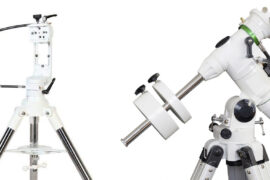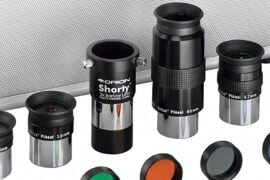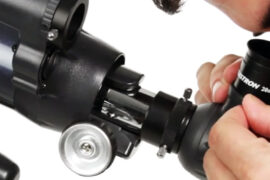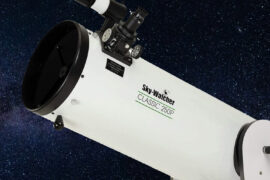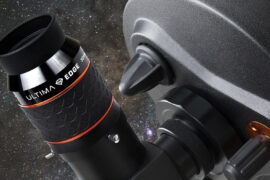One of the most common questions beginner stargazers have when it comes to telescope accessories is if it is better to get a collection of eyepieces of different magnification or if using Barlow lenses is better.
When it comes to Barlow lenses vs eyepieces, both approaches have advantages and disadvantages. For beginners, Barlows are the most practical and economical method to get access to many magnification levels. But as you grow your eyepiece collection sometimes you end up with so many that Barlow lenses are no longer necessary except for specific use cases.
In this article, we’ll compare both methods so you can make an informed decision and pick the ones that better fits your particular situation.
Are Barlow lenses worth it?
Barlow lenses are worth trying for many reasons. The most obvious one is cost. A Barlow is going to allow you to instantly double the number of magnifications you can use with your telescope.
This not only reduces the investment you have to put into your accessories but saves a lot of space when you want to take your telescope into the field. Instead of having to bring a huge case full of a dozen eyepieces, you only need two or three and a couple of Barlows.
Barlows also have other advantages. For example, they can be used to artificially increase the focal length of a telescope and to increase the eye relief of the exit pupil. Because of this, people that wear glasses prefer to use a Barlow lens in their setup.
One of the main concerns about Barlows is whether or not they make the final image worse by increasing the number of elements light has to go through.
Every time you add an element to the optical chain of a telescope you are going to lose a little bit of light, and therefore brightness at the very least. It’s just physics. There’s also the possibility of introducing optical errors such as chromatic aberrations.
However, this effect is very dependent on the quality of the lenses or mirrors that are being used. With a good Barlow lens from a reputable brand, you are not going to see a noticeable difference in the quality of the image.
The image below shows how a Barlow shows less brightness and even different colors. The photos with the Barlow are in the second column. The effect is most obvious on the Jupiter image at the top.
Don’t pay much attention to the definition of the image. That is obviously going to be better with the Barlow because of the extra magnification. Look at the colors and brightness.
Credit to reddit user /u/Voxolous
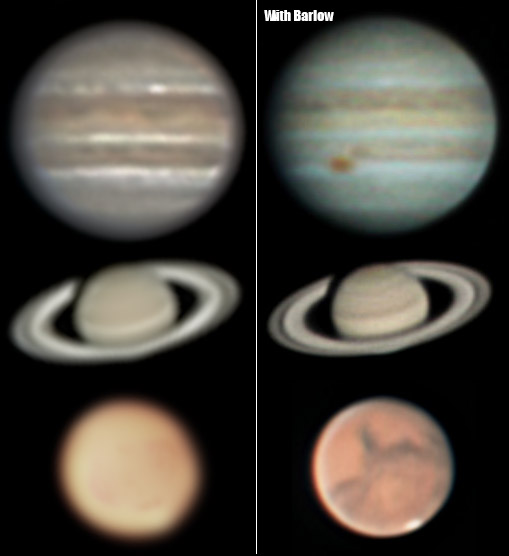
On the other hand, Barlows don’t always necessarily represent a noticeable loss in optics. They can sometimes end up displaying a much better image. Because of the additional magnification, you can gain increased sharpness and definition. Especially when taking photos.
The following comparison is a good example of this. The following images were taken using a 200mm Dobsonian telescope with and without a 3X Barlow. Credit to reddit user u/ALargenigerean. As you can see, even some of the color errors in the image below go away.
If you want a deeper understanding of the advantages and disadvantages of Barlow lenses, check out our Barlow lens guide.
Barlow lens vs Eyepiece
Let’s take a look at the pros and cons of using a Barlow lens vs just an eyepiece.
Barlow Lens
| Pros | Cons |
|---|---|
| * You save space by not having as many eyepieces * Very cost-effective way to build an accessory collection for your telescope * Increased eye-relief Increased back focus | * Smaller field of view * Can lose brightness or introduce optical errors if the lens is low quality |
Eyepieces
| Pros | Cons |
|---|---|
| * Better light-transmission * More predictable results in the final image * Greater field of view * You can have more variety for a specific use case, like wide FoV eyepieces. | * More expensive to purchase individually * High magnifications have low eye relief which can be uncomfortable for some people |
The quality and cost of both the Barlow or eyepieces that you plan to get also play a big role. If you are planning to get budget eyepieces then getting a lot of them might not be that big of a deal.
But if you are buying high-quality, expensive eyepieces, then buying all the magnification lineup will get expensive fast. In that case, a Barlow can complement them so you get the most use out of them.
Conclusions
Both Barlow lenses and eyepieces have their pros and cons. Choosing one method to start a collection is going to depend on your specific needs.
For starters, getting one or two Barlow lenses is usually the most practical and economical option. Check out our guide on the best Barlow lenses if you are on the market for one.
Once you have more experience and you feel the need to try fancier eyepieces, then might only end up using Barlows occasionally unless you want them for a specific purpose, such as increased eye relief.
Enjoyed this article?
Get daily 10-minute PDFs about astronomy to read before bed!
Sign up for our upcoming micro-learning service where you will learn something new about space and beyond every day while winding down.

